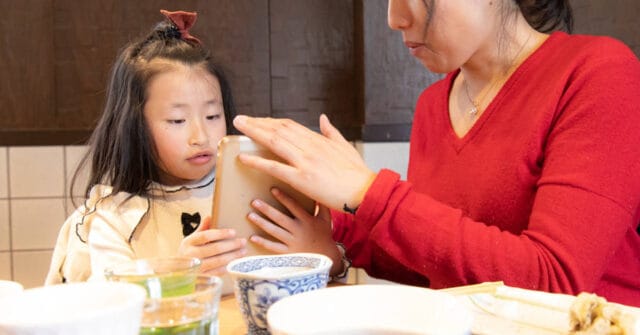It can be a serious stressor when your child will only eat if they’re distracted by a screen! There’s a way to help them learn how to eat without any screens, try these 3 tricks today…
Will your child ONLY eat if they’re distracted by a tablet that’s endlessly playing YouTube videos? Or, are they sitting in front of the TV watching Paw Patrol as you “sneak” bites into their mouth while they are distracted with the story and graphics that are unfolding before them?
If you answered yes to either of those questions, then this post was written for YOU.
You might feel like you’re the only one that has a child that will only eat with a screen, you are not. As an occupational therapist, I can assure you that lots of kids are struggling to eat and parents have to rely on using a screen to get any nutrition and calories into them.
While using a screen be a band aid to the problem, it’s not a long term solution. Let me tell you why…
Why Eating With a Screen Is a Problem
When anyone, child and adult alike, sits in front of a screen and eats, it’s a passive experience. That means a child that eats in front of a screen isn’t really aware of the textures, tastes, and smells of the food.
Their brain is primarily focused on the screen, so eating moves into auto pilot.
You might be thinking, “So what? I don’t care, as long as they eat.”
The problem with this passive style of eating is that a child isn’t learning to:
- Experience the tastes, textures, and smells of food
- Regulate when their belly feels full or they feel hungry for that matter
- Chew and manipulate a variety of foods well.
Hence why when you try to pull the tablet away, they totally refuse to eat. No progress has been made. No new foods really gained.
Not only is this a problem in your home, because a child can stay stuck eating in front of screens for years, but it’s also a problem anytime your child has to eat socially.

The Social Implications of Eating With a Screen
Depending on the age of your child, they may refuse to eat lunch at school because watching a screen isn’t an option in the cafeteria.
Going to birthday parties, family dinners, and other social outings also proves difficult, and can quickly become a source of stress if you can see your child is hungry and irritable but they refuse to eat without a screen.
Learn more about why to avoid using screens for meals in: Why Screen Time and Eating are a Bad Idea
When Using a Screen to Eat Can Be a Good Thing
Eating with a screen can be a necessary crutch. In some cases, it’s absolutely necessary as a short term solution until parents can begin to implement strategies that address the cause of the eating difficulties and make changes to their mealtime routine.
(You can grab our 9 Steps to Improve Eating printable that gives great tips for routines that support kids not using a screen to eat)
If you’re in a desperate situation right now, please hear me:
You don’t have to stop using screens right away, it can, and in most cases, should be a process hopefully under the guidance of a feeding therapist or as a student in our Mealtime Works program. Eliminating screens during meals is one of the many things parents learn inside the program.
Read this update we just received from one of your new students, it’s so good:
“He does not need a screen for meals. Stopped asking for it after a week or so of starting the program. He is eating a good variety, most food groups. Added new foods like pomegranate, ravioli, pizza, biryani (mixed rice), and curd to his regular foods.”

There’s a Reason Your Kid Will Only Eat in Front of a Screen
This article is not about the kid that has too much screen time in their life and is just having a tantrum because they want to keep watching their screen. (Check out some tips on reducing your child’s overall screen time throughout the day)
As a parent, you know when your child needs the screen to eat.
You know because you were trying to feed your child without a screen and they wouldn’t eat. They’d tantrum, throw their food, or blatantly refuse to eat meal after meal. You’ve wondered how they could survive on so little.
Using a screen was a desperate solution when you were at the end of your rope wondering if your child would eat anything at all.
Flat out refusing to eat or barely eating for many meals and having extreme distress around food is not typical for kids. It’s not a part of development that we expect to see, and it’s a sign that there’s something else going on.
That could be poor oral motor skills, sensory processing, acid reflux, food intolerances, and more.
Head over to 5 Reasons Kids Won’t Eat to learn more about some of the most common reasons kids will rely on a screen to eat.
3 Tricks to Get Kids to Eat Without a Screen
With that being said, an important part of eliminating screens completely is addressing the feeding difficulties that have created the dependence on them. It’s also having a solid routine and positive eating environment as well.
In this article, I want to share 3 tricks or methods you can use to get your kid to eat without a screen. Remember, that it will take time. Don’t give up after a meal or two. The longer your child has used a screen to eat, the harder it will be to take it away.
Keep reminding yourself that it’s a process not a switch you can flip because your child is having a hard time eating.
The 3 Screen-Eliminating Tricks:
#1. Change Up the Routine
Kids thrive on routine, and likely you have one when you feed your child, even if you didn’t intend to. Part of the challenge of removing the screen is that it disrupts what they’re used to. They often feel unsure of themselves and maybe like they’re under a microscope of pressure to eat without the distraction of the screen.
That’s why it can be helpful to change up your routine. If you usually feed your child on the couch in front of the TV, set up lunch in the kitchen, maybe with some fun plates and napkins.
Although reading books can still be a distraction, you could offer to read a story while you eat as a transition away from the screen with the ultimate goal of not using books as a distraction either.
Or, if you usually sit at the table, but bring the tablet along, then try and pack a lunch or dinner picnic and eat outside. Don’t even mention the screen, the change in routine will hopefully prevent them from even asking for it.
Whatever your routine currently is, think about how to break that up and simply NOT bring or turn a screen on. If your child asks for it, you can say, “Oh, it’s charging, maybe later. Help me spread out the blanket for this fun picnic lunch.”
When you avoid putting an emphasis on the screen and redirect to something else, your child will likely roll with it. If they don’t, then try the third trick below.
#2. Eat together at the table
When our kids aren’t eating well we usually get so focused on feeding them quickly while they’re distracted that we don’t eat a meal together. As you change up your routine, make it a priority to eat with your child.
Not only does this model for your child how and what to eat, but it teaches them that meals are a shared experience that are about more than just eating.
Sitting down for meals is about stopping in the middle of the day and spending time together. Focus on your interactions for these meals, not that the tablet isn’t at the table or how much for your child is eating.
Let the goal of the meal be on enjoying your time together.
#3. Slowly decrease screen time by starting/ending meals without the screen
You can use this trick in combination with the other tricks or all on its own. The idea is that you either delay giving your child the screen so they have a chance to start the meal without it, or you take away the screen before the meal is over so they can finish the meal without it.
Whichever way you think your child will respond better to.
You can start by delaying giving your child the screen for 2-3 minutes. When your child comes to the table and starts asking for the tablet, you can say, “Oh sure, let’s get started first and then I’ll go get it.”
Or, towards the end of the meal, you might say, “It looks like that video’s done, the tablet’s going to take a rest now while we finish dinner.”
Once your child becomes used to the late start or early finish of screen time, you can start to increase the time. Maybe on Monday they wait 2 minutes until starting their tablet, on Wednesday they wait 4 minutes, and then on Saturday they wait 7 minutes.
How quickly you increase the time will depend on your child. You want to push them a little out of their comfort zone, but not so far they totally refuse. The idea is for this transition to be as stress free as possible.
What do you say? Are you ready to give it a try. I can’t stress this enough: you aren’t alone in this. If you have any questions, leave them in the comments below, we respond to every single one.

Free Printable!
Make sure you sign up for our Picky Eating Essentials Guide if you haven’t already. Along with the guide, you’ll get the 9 Steps to Improve Your Kid’s Eating Printable!
Click here to get the guide! We’ll send it right to your inbox immediately.
More Help for Eating Difficulties
Are Food Jags Affecting Your Picky Eater? What You Need to Know
Her Picky Eater Ate New Foods Because of This Surprising Trick
Pocketing Food Strategies and Causes in Kids
Perfect Lunch Ideas for Picky Eaters at School, Home, or Daycare
Alisha Grogan is a licensed occupational therapist and founder of Your Kid’s Table. She has over 18 years experience with expertise in sensory processing and feeding development in babies, toddlers, and children. Alisha also has 3 boys of her own at home. Learn more about her here.


This is so informative. I wasn’t aware that when kids eat with a screen on its a passive experince, wow. I appreciate the involvement of the sense of smell, taste and the GIT just to cater the awareness as well as the feeling of being hungry or not. Thank you so much for this informatiom
You’re welcome, Nyasha! So glad to hear it was helpful 🙂
Best,
Andrea
This is really helpful in understanding why a child shouldn’t have screen time with food, but a lot of the understanding won’t apply to my 16 month old. I feel terrible I’m in this situation as I’ve been guilty of lazy parenting. But now he just point blank refuses to eat anything without it, and he isn’t old enough to reason with! I’ve changed routine, and his sister eats at the table with him. Is there anything else I can try?
Hi Lori,
Don’t beat yourself up. Try little by little decreasing the time with screens at the table. Maybe using a visual timer and starting with the screens and then decreasing the amount of time you have it at the table little by little. It will frustrate him at first but staying consistent, even removing it for the last minute or two of the meal at first will be a starting point and he will be able to slowly adjust.
Best,
Laura
Your Kid’s Table team member
I can’t get my twins to sit still or sit at the table long enough to engage with their meal. The screen captures their attention so that they actually remain in their seats and we get some food in…! They’re almost 4 years old and definitely passive and picky eaters. They still drink Pediasure to supplement. History: Micro prem 26 weekers born at 540g and 825g. Over 100 days in NICU.
Hey! Oh it sounds like they had a challenging start, which can definitely play into some of their struggles. When kiddos are really resistant to mealtimes it can be really helpful to try to get rid of the screen slowly. Also cutting down the time they’re expected to sit at the table can be helpful in the beginning too, sometimes down to even just 5-10 minutes at a time ❤
Best,
Andrea